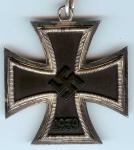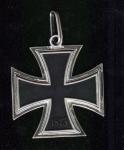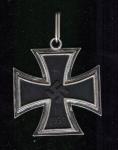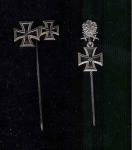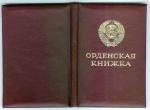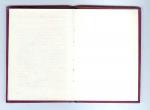-
Posts
212 -
Joined
-
Last visited
Content Type
Profiles
Forums
Blogs
Gallery
Events
Store
Everything posted by Dietrich
-

EK 1939 "Frosty" EK1
Dietrich replied to Gordon Williamson's topic in Germany: All Eras: The Iron Cross
Hi Gordon, now that is really true! And what a nice cross that is! Beautifull! Dietrich -

EK 1939 1957 Knight's Crosses
Dietrich replied to Gordon Williamson's topic in Germany: All Eras: The Iron Cross
Brian, then let's leave it at that! Wait for provenance of the 935, 800, and all the others. Till then, my opinion stands for me. Dietrich -

EK 1939 1957 Knight's Crosses
Dietrich replied to Gordon Williamson's topic in Germany: All Eras: The Iron Cross
Brian, I do not know whether B-Type "800" crosses are post war and I never said so! If somebody ask me of my opinon I would tell and have told exactly this: The last B-Type with provenance I'm (and a lot of others...) are aware of is the 935-4. And there are post war manufactured S&L crosses, B-Types mind you, IMHO. If you elect to believe that all the 935, 800, unmarked, Neusilber, zink and heavily flawed are made from left over parts, okay. The post war crosses start somewhere, that's sure. With the 800? With the 935? With the Neuliber Zink? I don't know! Safe is only the 935-4, IMHO. Dietrich -

EK 1939 1957 Knight's Crosses
Dietrich replied to Gordon Williamson's topic in Germany: All Eras: The Iron Cross
Brian, it was always clear that the 935-4 is a late war cross. Just because nobody did pay attention to the A and B Type before the determination doesn't mean anything. It was long before that that the 935 - as an example- was deemed post war. The B-type discovery just confirms it. And the above shown cross confirms it, too. I'm nor skirting anything here. I showed you a B-Type cross with war time core that is clearly made post war. Or don't you think so? And again, so far the 935-4 is the last S&L with provenance, found at Klessheim together with Lazy 2's. The flat numeral core you refer to above is just another example of the business behaviour of S&L in the post war years. You cannot believe that this was the first done on purpose after the war and everything else was left over stock? Dietrich -

EK 1939 1957 Knight's Crosses
Dietrich replied to Gordon Williamson's topic in Germany: All Eras: The Iron Cross
Brian, I did not make the conclusion that the B-type is post war. You are trying to put this into my article. I clearly said, that the 935-4 (which is the last S&L RK with solid provenance) is a B-Type! Therefore, the B-Type was in use during the war, i.e. at the very end. All the models after that (800-4, 800, 800 incuse, 935, unmarke, zinc core, ...) might or might not be post war, but surely some are! I don't know the cut off point and I never pretended to know. All I know ist that the 935-4 is the last with provenance. Dietrich -

EK 1939 1957 Knight's Crosses
Dietrich replied to Gordon Williamson's topic in Germany: All Eras: The Iron Cross
Brian, so this cross is pre-45? Flaws all over the place, B-Type, no flat core numerals, rather the usual! I don't think I came to my (and only my!) conclusions lightly. And I don't skirt the obvious also. Ther are also unmarkes Zink core B-Types with the 'regular' core. War type? I don't think so. Dietrich -

EK 1939 1957 Knight's Crosses
Dietrich replied to Gordon Williamson's topic in Germany: All Eras: The Iron Cross
Brian, I certainly don't weant to start a renewed discussion about this subject but allow me kindly to ask why this cross (which is absolutely nothing new - I quoted Gordon in my article about this already) is proof that the die was repaired? Whjich - by the way - really doesn't matter to me, i.e. repaired or new! And I don't think so! I mean the post war all have a new core. But if you believe that it's also fine with me. Dietrich -

EK 1939 Little and Large
Dietrich replied to Gordon Williamson's topic in Germany: All Eras: The Iron Cross
Gordon, here's the comparison. Not the same. Dietrich -

EK 1939 Little and Large
Dietrich replied to Gordon Williamson's topic in Germany: All Eras: The Iron Cross
Brian, yes, that is a puzzle that might be impossible to solve. IF the story if post war restrikes is true and 'they' made them in the same quality as pre-war, how could one ever know? The first order of business in this case really would be to find out whether Bills' story is true. But how could that be done? We might never find out! Dietrich -

EK 1939 Little and Large
Dietrich replied to Gordon Williamson's topic in Germany: All Eras: The Iron Cross
Brian, from all I know it came from Klessheim. But I was not there picking it on my own, true! So there's always a certain level of "believe it or not". However, it seems to be a genuine Juncker. Dietrich -

EK 1939 Little and Large
Dietrich replied to Gordon Williamson's topic in Germany: All Eras: The Iron Cross
As you surely know ( ) this cross is from Klessheim. Let me try to compare the corners.. Dietrich -

EK 1939 Little and Large
Dietrich replied to Gordon Williamson's topic in Germany: All Eras: The Iron Cross
-

EK 1939 Little and Large
Dietrich replied to Gordon Williamson's topic in Germany: All Eras: The Iron Cross
-

EK 1939 Little and Large
Dietrich replied to Gordon Williamson's topic in Germany: All Eras: The Iron Cross
-

EK 1939 Schinkel Form EKs
Dietrich replied to J Temple-West's topic in Germany: All Eras: The Iron Cross
George, this is a general problem! Not only in Germany, as we know. It is so much easier to just say "fake" without any reason, shrouding oneself in a veil of mysterious knowledge then explaining why one thinks so (at least). The majority of the guys in this particular german forum are good at the common stuff, but will not venture into "unknowns". No pioneer spirit, so to say. I found your reasoning compelling. I weigh this alweays in my minds against "odds' and possible "faker intention". In this case, this being a fake makes no sense. And somebody had to make them, right? Dietrich -
Hi Richard, Bowen's book is very good, considering the time it was written. It has ton's of usefull information and also some mistakes. But this is the case with all these books. The imidiate information exchange on the net allows for an accelerated rate of 'new' knowledge. The same applies to Geissler's book (I guess that's what you meant) However, Geissler is more into the awardees, not so much into the technical and/or production aspects. This really only started with Gordon's book and he cannot be commended strongly enough to brake open this truly new approach to the collecting. If you are looking into another good book, buy Bowen! It's absolutely worth it but you might have problems finding it. I was fortunate enough to get a copy for araound $ 200,-. Dietrich
-

EK 1939 Little and Large
Dietrich replied to Gordon Williamson's topic in Germany: All Eras: The Iron Cross
-

EK 1939 Steinhauer Knight's Crosses
Dietrich replied to Gordon Williamson's topic in Germany: All Eras: The Iron Cross
Hi Richard, if that's the cross I saw at the SOS it's a very fine one. I got pictures of the cross from you during the writing of the article and it is an A-Type. Dietrich -

EK 1939 Steinhauer Iron Cross Production.
Dietrich replied to Gordon Williamson's topic in Germany: All Eras: The Iron Cross
Maybe they left out a step? "Versilbern" is not the same step as putting on the frosting. Somehow the frosting was applied to the frame without leaving any trace on the core. I surely don't know how they did it but I know that they did it soemhow. As a process related engineer I have no explanation whatsoever how this could be done with a fully completed cross. But okay, if there's no answer yet, there's no answer yet. It doesn't change the fact of the final product and has no impact on originallity. Just another puzzle to be solved. Dietrich -

EK 1939 Steinhauer Iron Cross Production.
Dietrich replied to Gordon Williamson's topic in Germany: All Eras: The Iron Cross
Gordon, if one looks at a EK1 or EK2 one can see that there are two finishing steps, basically. One is the silver coating of the frame and the second one is the 'frosting compound'. Now I honestly could believ that the silvering was done with the finished cross since most likely the galvanic process had no effect on the painted core. But the 'frosting compound"? How could one achieve to frost the frame with this paint type without leaving ANY trace on the core? The full frame was frosted as can be seen under a microscope. The outer rim was burnished thereby removing the frosting. I really don't know how to reconcile all this? Dietrich -

EK 1939 Steinhauer Iron Cross Production.
Dietrich replied to Gordon Williamson's topic in Germany: All Eras: The Iron Cross
Gordon, thanks for the nice picture row! I have a question that bugs me for quite some time. I was stated in publications of the time, that the master graveur of S&L, Mr. Escher, did the initial die and ALSO all subsequent dies for the other companies. Can this be true and if yes, why are the dies different? What can you say or do you know about this? T.hjanks, Dietrich -

EK 1939 Steinhauer Knight's Crosses
Dietrich replied to Gordon Williamson's topic in Germany: All Eras: The Iron Cross
If you ever need some very good pictures taken with a microscope for whatever badge, let me know. Always of service! Dietrich -

Soviet Order of Friendship of Peoples
Dietrich replied to Dietrich's topic in USSR: Soviet Orders, Medals & Decorations
-

Soviet Order of Friendship of Peoples
Dietrich replied to Dietrich's topic in USSR: Soviet Orders, Medals & Decorations
-

Soviet Orders Books: Editions & Series
Dietrich replied to a topic in USSR: Soviet Orders, Medals & Decorations


